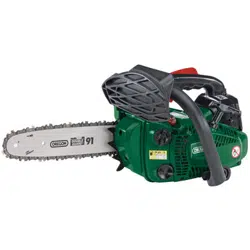Loading ...
Loading ...
Loading ...

Warning: Do not start the chain saw before mounting
and correctly adjusting the guide bar and chain.
Attention: Saw chain is extremely sharp – wear gloves
when handling chain.
8.1 ATTACHING/ADJUSTING GUIDE BAR
AND CHAIN (FIGS.1 – 12)
– Position the power head as shown (Fig.1). Ensure
the chain brake is disengaged. To disengage, pull
the chain brake lever (5) towards the front wrap
round handle (4).
– With the combination box spanner (32), remove
the guide bar locking nut (20).
– Using the hex. key (36) remove two M6 hex
screws.
– Pull the clutch cover (21) away and off the
machine.
– Fit the saw chain (3) around the drive sprocket
(25) paying particular attention to the cutter
orientation. An incorrectly fitted chain is
dangerous.
– Note: The chain is driven on the top of the guide
bar away from the power head. Stamped on the
saw chain cutters and links is a direction of
rotation arrow. Ensure the drive sprocket teeth
have correctly meshed with the drive links.
FIG.1
FIG.2
FIG.3
FIG.4
(5)
(32)
(20)
(36)
(32)
(21)
(23)
(3)
9.6 KICKBACK (FIG.24)
Kickback – Definition:
– Rapid upward and/or backward motion of the
chain saw which can occur when the moving
saw chain near the tip of the guide bar
contacts an object such as a log or a branch.
Kickback is the most common hazard associated with
chain saws and can result in serious injuries, and
even fatalities.
– This chain saw features an inertia activated chain
brake and a manually triggered chain brake. In
the event of a particularly strong kickback inertia
generated releases the brake lever triggering the chain brake. If the kickback is less the chain
brake lever will activate on the operator’s left hand (hence the necessity to always operate the
saw two handed). There are different types of kickback and a couple of other associated risks.
– Because the saw chain is driven along the top of the guide bar away from the power head,
contact with the kickback zone can translate the chain movement in the opposing direction on
the guide bar. This is particularly the case if the chain becomes pinched or snags in the
kickback zone of the guide bar.
– Another kickback danger can result in the chain saw being forced horizontally back towards
the user. Kickback of this nature is the result of the chain along the top of the guide bar being
pinched, translating the force backwards through the guide bar.
– The opposite of kickback is having the chain saw pulled away. Pull-in can be a result of the
chain pinching along the bottom of the guide bar. As the chain along the bottom of the guide
bar is returning to the power head the translating force pulls the chain saw from the operator’s
hands.
– In addition to kickback, risks such as skating and bouncing can lead to a loss of control of the
chain saw. If the chain fails to make an initial incision it can move sideways along the timber
‘skating’ or ‘bouncing’. This sideways movement can result in off balancing, overstretch,
further loss of control or contact with the guide bar tip on another limb causing a kickback.
– To avoid kickback occurring, do not use the tip of the guide bar. Take note of foreign objects
and other branches/limbs close to the area being cut.
Note: They may not be in your line of sight. Always make the initial cut on the tension surface
of the timber and use non metal spreading wedges to avoid the timber pinching the chain.
Always begin cutting at full speed and ensure the body of the saw, in particular the spiked
bumper, is against the timber.
– Cut only one piece of timber at any time and observe the timber while making the cut to
ensure the tension was assessed correctly. Hold the chain saw firmly as described. Maintain a
good firm stance and do not over reach. Do not cut above shoulder height. The use of a low
kick back saw chain is also advised. These are designed specifically to help reduce the factors
leading to kick back. Do not solely rely on the chain brake to stop an accident occurring or
chain saw ppe to avoid injury. They are a deterrent.
FIG.24
KICKBACK
ZONE
- 22 -
- 15 -
9. OPERATING INSTRUCTIONS
8. ASSEMBLY
Loading ...
Loading ...
Loading ...
